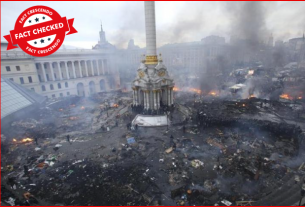
Viral posts on social media have claimed that the majority of the world’s Muslim refugees avoid seeking asylum in Muslim-majority countries, preferring instead to settle in non-Muslim nations. This framing has been widely shared online, raising questions about the true religious composition of refugees and where they most often find protection. Our fact-check shows that these claims are not supported by available refugee statistics or credible research.
Social Media Post
A viral claim has been widely shared on social media platforms stating: “Approximately 85% of the world’s refugees are Muslims. But they don’t seek asylum in any of the 56 Muslim countries, they only seek asylum in non-Muslim countries.” These viral posts have been shared hundreds of times and garnered over 100,000 likes.


Fact Check
Refugee Religious Composition
The first part of the viral claim states that 85% of the world’s refugees are Muslims. According to available data, this figure does not appear to be accurate. UNHCR, the primary international agency for refugees, does not report refugee statistics by religious affiliation. Pew Research Center, which analyzes global religion and migration data from numerous censuses and surveys, indicates that Muslims comprise approximately 29-30% of the world’s migrants, which is significantly lower than the claimed 85%.
Additionally, refugee movements in recent years show that large populations of displaced people are not Muslim. For example, the war in Ukraine created millions of predominantly Christian refugees, while Venezuela’s ongoing crisis displaced another large Christian-majority population. According to UNHCR’s Global Trends Report 2024, these two countries alone accounted for nearly one-third of the world’s displaced persons, making it mathematically impossible for Muslim refugees to represent 85% of the total.
Where Refugees Actually Seek Asylum
The second part of the claim suggests that Muslim refugees avoid Muslim-majority countries and choose only non-Muslim destinations. This portrayal is also inaccurate. In reality, most refugees seek safety in the nearest available country, regardless of religion. Geography and proximity play a far greater role than religious identity when displaced people decide where to go. Humanitarian organizations such as the Red Cross emphasize that refugees usually cross into neighboring states because they lack the means to travel long distances.
Data shows that many refugee-hosting nations are Muslim-majority countries. Turkey has been one of the world’s largest refugee hosts for years, providing shelter to millions of Syrians and others. Iran and Pakistan have hosted millions of Afghan refugees over decades. Bangladesh provides refuge to hundreds of thousands of Rohingya Muslims who fled Myanmar. Chad, a Muslim-majority country in Africa, has accepted significant numbers of refugees from neighboring regions.
While Saudi Arabia and the United Arab Emirates are not signatories to the 1951 Refugee Convention, they serve as destinations for Muslim migrants and displaced persons. According to official statistics, Germany is the only non-Muslim-majority country consistently ranking among the top refugee-hosting nations, with several Muslim-majority countries comprising the majority. This data contradicts the assertion that Muslim refugees avoid seeking asylum in Muslim countries. (Source)
Why Religion Data Is Limited
One reason misleading figures can spread easily is that global refugee data is not usually broken down by religion. UNHCR collects and publishes statistics based on country of origin, host country, gender, and age, but religion is rarely included due to privacy and political sensitivities. Religion data may be gathered in limited circumstances, such as when specific religious minorities face persecution or need special protection, but it is not part of standard global reporting.
Due to this data limitation, information about refugees’ religious affiliations primarily comes from independent research organizations such as Pew Research Center, which develop estimates by analyzing census data, surveys, and demographic modeling based on countries of origin. Some national statistical agencies, like Germany’s Federal Office for Migration and Refugees (BAMF), collect and publish data on asylum seekers’ religious backgrounds. However, this information varies significantly across different countries and regions.
Why Refugees Move the Way They Do
According to UNHCR’s Global Trends 2024, by the end of 2024 there were about 42.7 million people classified as refugees under UNHCR’s mandate globally. While the report does not break down refugees by religion, the distribution of those refugees across hosting nations reinforces that several Muslim-majority countries are among the top hosts, contradicting the idea that Muslim refugees avoid Muslim-majority asylum destinations.
For example, UNHCR lists Iran as hosting approximately 3.5 million refugees, making it one of the top refugee-hosting nations in 2024, and Turkey with around 2.9 million refugees. Pakistan, another Muslim-majority state, also housed a notably large refugee population (though lower than its peak). These figures highlight that significant numbers of displaced persons do indeed settle in Muslim-majority countries.
Understanding refugee settlement patterns requires examining multiple factors. Geographic proximity is a primary consideration, as refugees typically cross the nearest border when fleeing danger. The capacity, infrastructure, and policies of potential host countries also influence migration patterns. Countries that border conflict zones, including Muslim-majority nations such as Turkey, Iran, and Pakistan, often receive large numbers of displaced persons. Meanwhile, countries with established resettlement programs like Germany or Canada may become subsequent destinations for some refugees.
Some Muslim-majority countries have not signed the 1951 Refugee Convention, which affects their formal refugee processing capabilities. However, data indicates significant refugee populations do reside in Muslim-majority countries. The distribution of displaced persons across different nations reflects complex geopolitical realities rather than religious preferences.
Source: Euronews, Concern, Red Cross
Conclusion
The viral claim that most refugees are Muslims avoiding Muslim-majority countries is false. Pew Research data shows Muslims comprise only about 29-30% of global displaced populations, not 85%. UNHCR reports that several major refugee-hosting nations are Muslim-majority, including Iran (≈3.5 million refugees), Turkey (≈2.9 million), Pakistan, Bangladesh, and Chad.
Muslim refugees don’t make up 85% of refugees globally, and millions do seek safety in Muslim-majority countries. Refugee movements are primarily determined by geography, proximity, and host capacity, not religion.

Title:Claim that 85% of World’s Refugees Are Muslims is False
Fact Check By: Cielito WangResult: False






